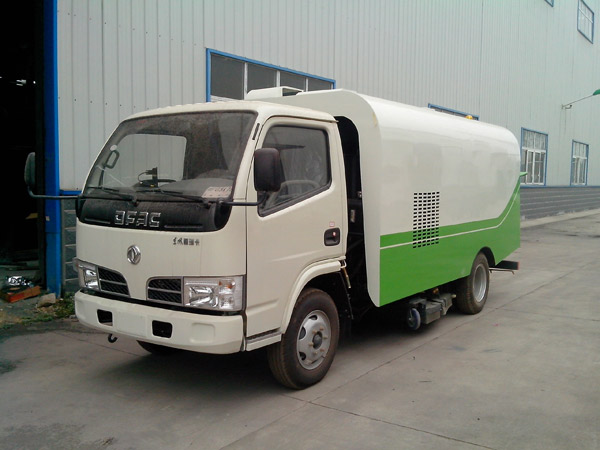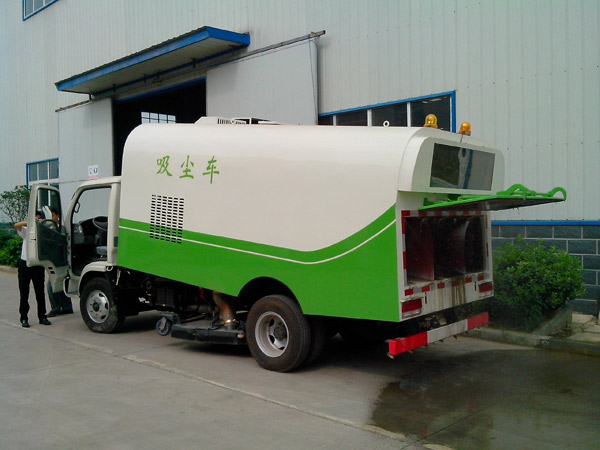Particulate pollutants are the primary pollutants in urban air pollution, and dust from transportation has the greatest impact on particulate matter concentration. Reducing all kinds of dust into the road and cleaning the road is the main measure to control traffic dust pollution. Tests and studies on the emission concentration and dust collection efficiency of various sweeping vehicles at home and abroad show that advanced sweeping equipment can effectively control traffic dust.
The computational fluid dynamics technology was used to simulate and optimize the flow field of the vacuum system of the vacuum cleaner . The simulation uses an unstructured grid to mesh the nozzles and uses the standard double equation as the turbulence calculation model. Through the flow field simulation analysis of the initial design scheme, the reason that the dust collection efficiency is affected is the irrational flow field distribution caused by the structure. By improving the structure of the original simple connection method to the structure of the transition connection and the shrinkage angle of the flat belt on the suction cup, the flow field distribution is rationalized, and the dust collection efficiency is improved.

The vacuum cleaner is a new concept of a pure suction type vacuum cleaner. It uses the negative pressure generated by the high pressure fan to suck particles into the recovery box. The vacuum cleaner is divided into two parts, the vacuum system and the dust reduction system. Vacuum cleaners have reduced operating costs (for example, eliminating the need for replacing brushes), eliminating secondary dust due to sweeping with conventional sweepers. For a system or component under analysis, high RPNs should be given priority and focused. It takes measures, and then regardless of the size of the RPN, when the severity of the failure mode is large, special attention should be paid to it.
In the analysis of double sealing door work and FMEA analysis, it is assumed that there are no secondary accidents. The double-geared three-stage gear train rotation is the main failure mode, because at this time the internal components that need to be repaired have already got into the car box, and at that time the maintenance door cannot be locked to the window, so if you drive away, the consequences are serious. As the internal parts of the window were exposed in the hall, the entire hall was contaminated. In addition, the gear train is partially fixed on the car door, and a part of it is fixed on the maintenance door. The two butt joints need to be well matched to work properly. Its remote control and precision determine the frequent and difficult occurrence of gear train faults. Detectability is relatively high. Motor failure, sleeve rotation failure is the second failure mode and the third failure mode. Although the RPN is not very high, the severity is 8, and it is the highest among all faults. Special attention must be paid during operation. Because it is impossible to rescue the door through a remote control trolley, the operator can only operate directly through the window. This risk is the greatest and most insecure. Once the error occurs during the operation, it will be the entire vacuum chamber. All contaminants and radioactive materials are in direct contact with humans.

Through FMEA analysis, it was found that the most prone to failure was a three-stage gear train, followed by motors, sockets, plugs, hydraulic rods, bayonet, etc. The failure mode that caused particular attention was the insertion tip, and found the ITER remote-controlled transporter double-seal door The weak links and potential weaknesses of the system provide the basis for the links that should be noted during the overhaul, maintenance and operation. Also for the reliability analysis of the next ITER other systems and important components.
Inspection and preparation before use: 1. Regularly check the oil level of each engine oil, and avoid starting the engine when the engine oil is insufficient or excessive; 2. Check if the fuel is sufficient; 3. Check whether the hydraulic oil in the hydraulic tank is sufficient. Or proper amount; when the cylinders are all in the retracted state, the oil level in the tank must not be lower than 2/3 of the highest mark of the cursor, and whether the hydraulic system has leakage or blockage; 4. Check whether the connection parts of the structural parts are Reliable; 5. Check for adequate tire pressure.
Operation and use: 1. Start the vehicle, wait a few minutes for the engine to idle, reach the normal operating temperature before running or driving at high speed; 2. After the vacuum cleaner travels to the working surface, stop and position the vehicle in the neutral position. 3. Depress the chassis clutch pedal and press the power take-off button; release the clutch pedal, the power take-off buzzer sounds, and the power take-off device drives the hydraulic oil pump to start working; 4. Place the sub-engine ignition switch on the control box to the right Turn to the "ACC" stop, the power indicator light, the joystick on the control box to the "main suction down" direction to pull the push rod, down the suction mouth, suction nozzle from the ground about 0.5 cm is appropriate, necessary The height of the caster can be adjusted. 5. Depress the clutch pedal, press the power take-off button to release the power take-off device, and the power take-off buzzer will not buzz. 6. Rotate the secondary ignition key switch to start the secondary engine. . The secondary engine speed is controlled by the throttle handle; when starting the secondary engine, the clutch pedal of the secondary engine should be depressed first, then the throttle handle should be pulled up slightly to a certain position, slowly release the secondary transmission clutch pedal, start the fan, and adjust the throttle handle so that The fan slowly reaches the required working speed; at the same time, the back blowing system switch can be turned on; 7. If the auxiliary suction port is working, open the sub suction port from the retracted position to the working position; the cleaning process is the same as above. When the auxiliary suction nozzle and the road shoulder fit, it should ensure constant speed.
Discharging operation: 1. After the vacuum cleaner travels to the discharge location, stop the vehicle and put the vehicle in neutral, press the clutch pedal, press the power switch, release the clutch pedal, the buzzer sounds, and the power is taken. Drive the hydraulic pump to work; 2. Rotate the power knob (ie, ignition switch) on the control box to the “ACC†position by one turn to turn the power indicator on; 3. Turn the control lever on the control box to the “back door open†direction. Push the push rod to open the rear door; 4. Then move the lever on the control box to the direction of “lifting the box†to move the push rod, lift the carriage and discharge the material; 5. After the unloading is completed, it will be controlled. The joystick on the box toggles the push rod in the direction of "case drop" to drop the carriage. 6. After confirming that the carriage is completely down, press the box door close button to close the carriage back door and confirm that the door is fully locked. Turn the power knob on the control box to the off position and turn off the power indicator. After pressing the clutch pedal and pressing the power take off switch, the buzzer will stop before leaving the site.
Our die casting services for Household Appliance Aluminum Die Casting Parts include the use of aluminum alloys. A key advantage of using aluminum in the die casting process is its low cost - aluminum parts are much less expensive than parts produced by other manufacturing processes. From a functionality perspective, aluminum die cast parts typically weigh one-third less than steel parts, while still offering the strength and durability that is essential for any lighting fixture.
Benefits of Aluminum Die Casting for Household Appliance Aluminum Die Casting Parts include:
• Save a lot of expensive secondary costs.
• A variety of surface treatments and coatings meet the customer's need.
• Rugged casting shell
• Use completely recyclable materials to comply with environmental regulations
• Corrosion resistant and easy to clean
As one of
the leading die casting manufacturers with over 10 years of experience,
Zheke Mould Company has been offering superior die casting parts for household appliance manufacturing and other indudustries. With our professional
technicians and cutting-edge die casting process, every piece of our
parts comes out with reliable quality and cost effectiveness.
Household Appliance Aluminum Die Casting Parts
Household Appliance Aluminum Die Casting Parts,Vacuum Cleaner Shell,Aluminum Fan Blade,Customized Vacuum Cleaner Shell
Zheke Mould Technology Co. Ltd. , http://www.zkdiecasting.com